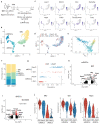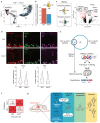Long-term self-renewing stem cells in the adult mouse hippocampus identified by intravital imaging
- PMID: 33349709
- PMCID: PMC7116750
- DOI: 10.1038/s41593-020-00759-4
Long-term self-renewing stem cells in the adult mouse hippocampus identified by intravital imaging
Abstract
Neural stem cells (NSCs) generate neurons throughout life in the mammalian hippocampus. However, the potential for long-term self-renewal of individual NSCs within the adult brain remains unclear. We used two-photon microscopy and followed NSCs that were genetically labeled through conditional recombination driven by the regulatory elements of the stem cell-expressed genes GLI family zinc finger 1 (Gli1) or achaete-scute homolog 1 (Ascl1). Through intravital imaging of NSCs and their progeny, we identify a population of Gli1-targeted NSCs showing long-term self-renewal in the adult hippocampus. In contrast, once activated, Ascl1-targeted NSCs undergo limited proliferative activity before they become exhausted. Using single-cell RNA sequencing, we show that Gli1- and Ascl1-targeted cells have highly similar yet distinct transcriptional profiles, supporting the existence of heterogeneous NSC populations with diverse behavioral properties. Thus, we here identify long-term self-renewing NSCs that contribute to the generation of new neurons in the adult hippocampus.
Conflict of interest statement
The authors declare no competing interests.
Figures









References
-
- Gage FH. Science. Vol. 364. New York, N.Y: 2019. Adult neurogenesis in mammals; pp. 827–828. - PubMed
-
- Goncalves JT, Schafer ST, Gage FH. Adult Neurogenesis in the Hippocampus: From Stem Cells to Behavior. Cell. 2016;167:897–914. - PubMed
-
- Eriksson PS, et al. Neurogenesis in the adult human hippocampus. Nat Med. 1998;4:1313–1317. - PubMed
Publication types
MeSH terms
Substances
Grants and funding
- MC_PC_17230/MRC_/Medical Research Council/United Kingdom
- 670757/ERC_/European Research Council/International
- 106187/WT_/Wellcome Trust/United Kingdom
- 157859/SNSF_/Swiss National Science Foundation/Switzerland
- BSCGI0_157859/Schweizerischer Nationalfonds zur Förderung der Wissenschaftlichen Forschung (Swiss National Science Foundation)
- 098357/WT_/Wellcome Trust/United Kingdom
- Stembar/EC | EU Framework Programme for Research and Innovation H2020 | H2020 Priority Excellent Science | H2020 European Research Council (H2020 Excellent Science - European Research Council)
- FC001089/WT_/Wellcome Trust/United Kingdom
- Braincompath/EC | EU Framework Programme for Research and Innovation H2020 | H2020 Priority Excellent Science | H2020 European Research Council (H2020 Excellent Science - European Research Council)
- 310030_196869/Schweizerischer Nationalfonds zur Förderung der Wissenschaftlichen Forschung (Swiss National Science Foundation)
- MC_PC_12009/MRC_/Medical Research Council/United Kingdom
LinkOut - more resources
Full Text Sources
Other Literature Sources
Molecular Biology Databases

